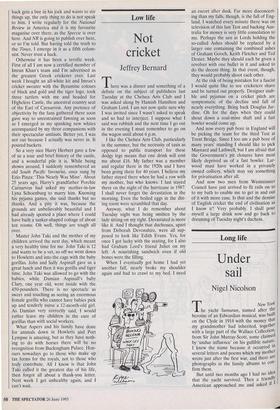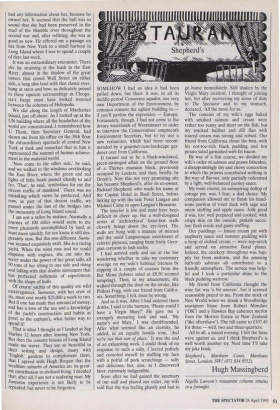Long life
Under sail
Nigel Nicolson
11New York he yacht Sumurun, named after the heroine of an Edwardian musical, was built on the Clyde in 1914 with the money that my grandmother had inherited, together with a large part of the Wallace Collection, from Sir John Murray-Scott, some claimed by 'undue influence' on his gullible nature. I knew the name because it occurred in several letters and poems which my mother wrote just after the first war, and there are photographs in the family albums to con- firm them.
But until two months ago I had no idea that the yacht survived. Then a friendly American approached me and asked if I had any information about her, because he owned her. It seemed that the hull was so sound that she had been preserved in the mud of the Hamble river throughout the second war and, after refitting, she was as good as new. He offered me a passage on her from New York to a small harbour in Long Island where I was to spend a couple of days last week.
It was an extraordinary encounter. There she lay straining at the leash in the East River, almost in the shadow of the great towers that crowd Wall Street on either side, a long slim boat with that classic over- hang at stern and bow, as delicately poised in these opulent surroundings as Cleopa- tra's barge must have looked moored between the columns of Heliopolis.
We slid along the length of Manhattan Island, just off-shore. As I looked up at the UN building where all the headaches of the world are concentrated, I remembered how U Thant, then Secretary General, had shown me from his office on the 38th floor the extraordinary spectacle of central New York at dusk and remarked that to him it represented the summit of human achieve- ment in the material world.
`Now come to the other side,' he said, and we walked to the windows overlooking the East River, where the green and red lights of little boats passed silently to and fro. 'That', he said, 'symbolises for me the decent traffic of mankind.' There was no mistaking which views he preferred. And now, as part of that decent traffic, we passed under the last of the bridges into the immensity of Long Island sound.
I am not a sailor by instinct. Normally a Journey of 100 miles would seem to me more pleasantly accomplished by land, at
least more quickly, for ten knots is still des- perately slow. But this was different. Sumu-
run seemed exquisitely swift. She is a racing yacht. When the wind rose and we could dispense with engines, she cut into the water under the power of her great sails, all 90 tons of her tilting to one side and rising and falling with that double movement that has perfected millennia of experiments with the shape of hulls.
Of course yachts of this quality are wild extravagances. Sumurun, with her crew of SIX, must cost nearly $25,000 a week to run. But if one has made that amount of money, and has a love of the sea and a knowledge of the yacht's construction and habits as great as the captain's, what better way to spend it!
That is what I thought as I landed at Sag Harbor 12 hours after leaving New York. But then the country houses of Long Island made me waver. They are so beautiful in their setting and design, many with English' gardens to complement them, that I agreed with Hugh Brogan that the wealthier suburbs of America are its great- est contribution to civilised living. I decided that, after all, I am not a seafaring man. My Sumurun experience is not likely to be repeated, but never to be forgotten.



























































 Previous page
Previous page